Organizational Change: Health, Safety, and Wellbeing Report
VerifiedAdded on 2021/04/21
|18
|4139
|69
Report
AI Summary
This report examines the significance of organizational and individual change management in fostering workplace health, safety, and employee wellbeing. It begins with an executive summary highlighting the importance of creating awareness among stakeholders regarding health and safety, and the adoption of strategies to manage safety in the workplace. The report delves into critical evaluations of approaches to organizational and individual change, emphasizing the role of individual change management by leaders in promoting a positive health and safety culture. It explores the Prosci change management methodology, including the ADKAR model and its components, and discusses proactive and reactive approaches to health and safety. The report also covers strategies like participatory ergonomics and the impact of organizational changes. The report uses examples of companies like Singapore General Hospital and Singapore Petroleum company to illustrate these concepts, the importance of a safety culture, and the application of change management models. Finally, the conclusion summarizes the key findings and the importance of integrating organizational and individual changes for a safer and healthier workplace.
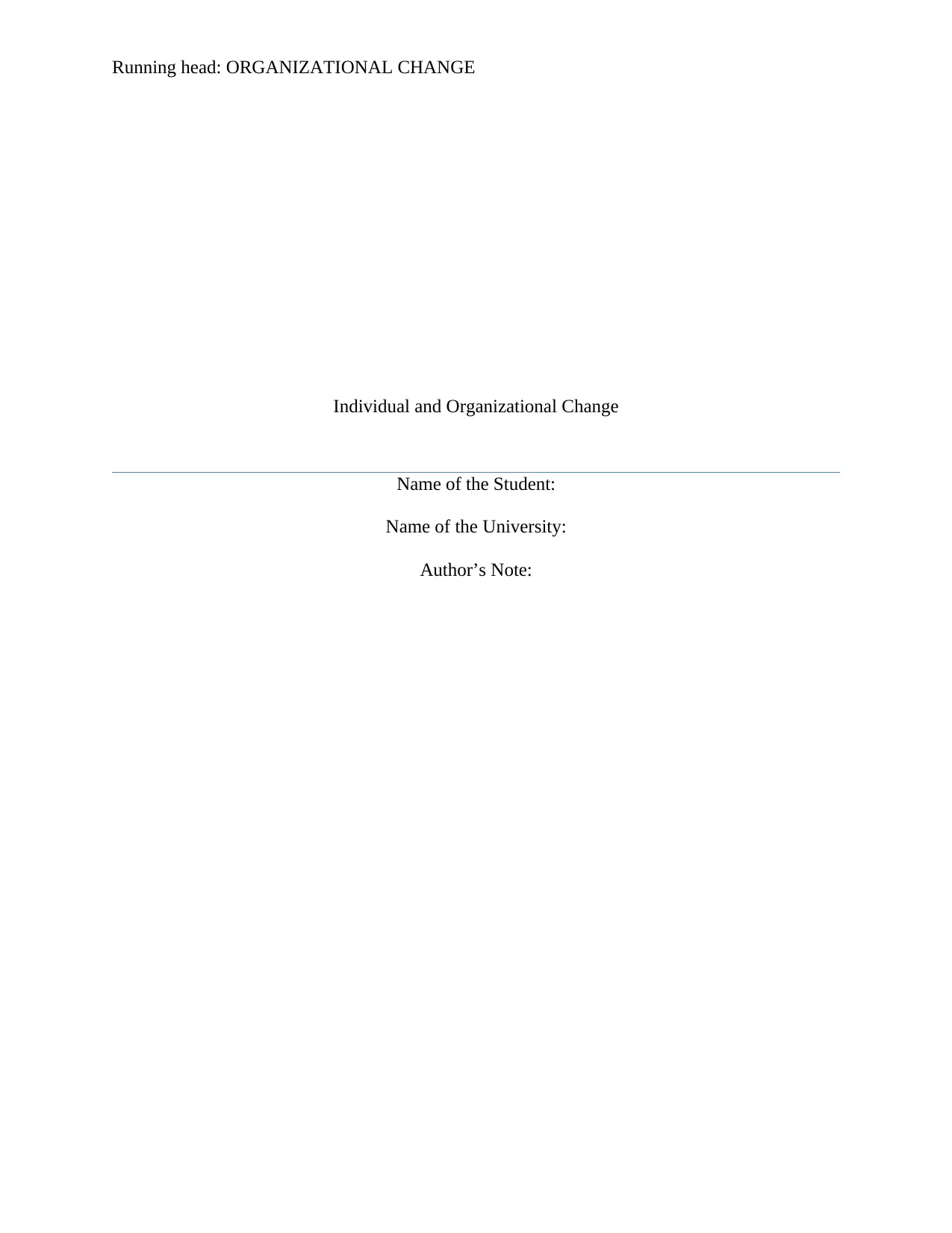
Running head: ORGANIZATIONAL CHANGE
Individual and Organizational Change
Name of the Student:
Name of the University:
Author’s Note:
Individual and Organizational Change
Name of the Student:
Name of the University:
Author’s Note:
Paraphrase This Document
Need a fresh take? Get an instant paraphrase of this document with our AI Paraphraser
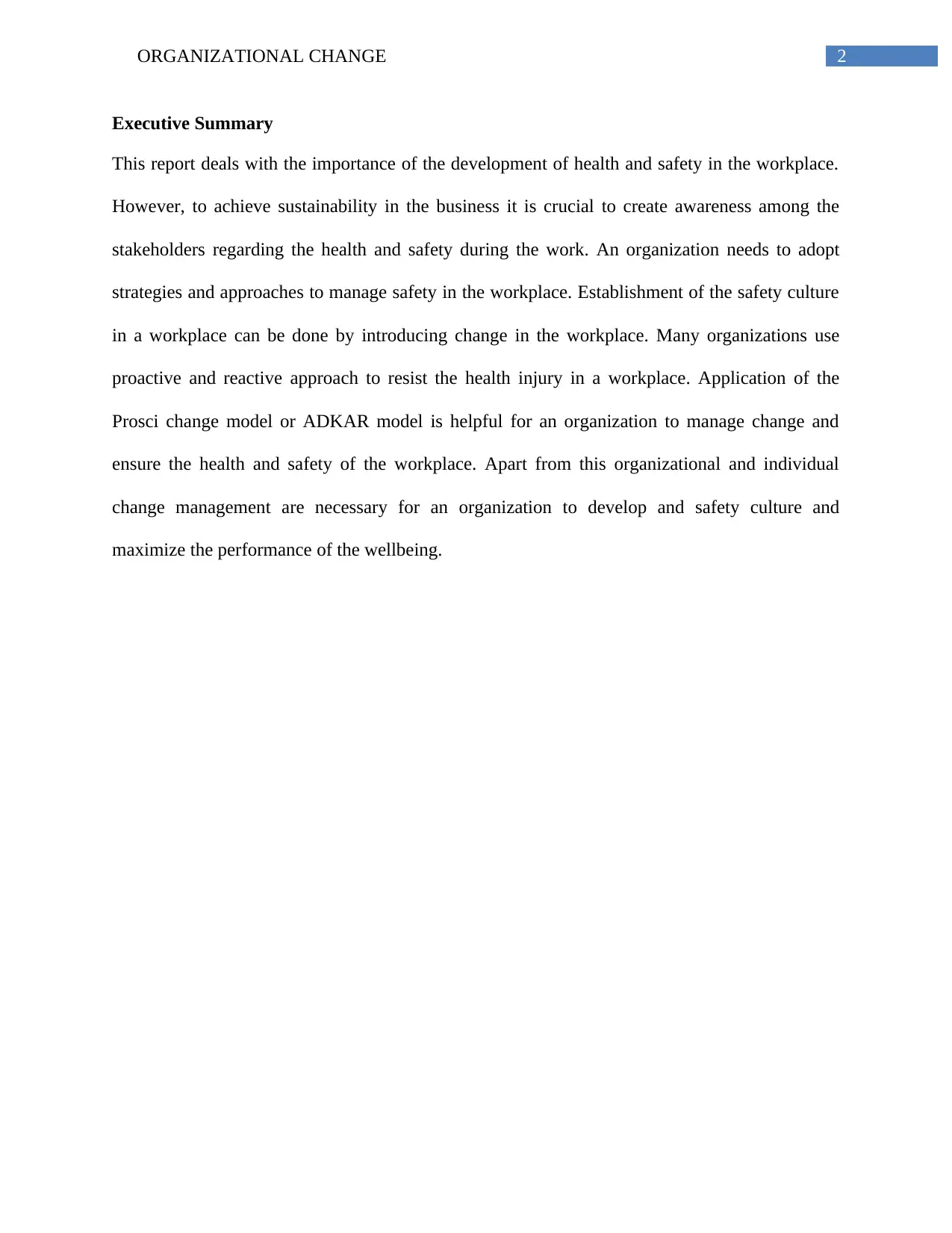
2ORGANIZATIONAL CHANGE
Executive Summary
This report deals with the importance of the development of health and safety in the workplace.
However, to achieve sustainability in the business it is crucial to create awareness among the
stakeholders regarding the health and safety during the work. An organization needs to adopt
strategies and approaches to manage safety in the workplace. Establishment of the safety culture
in a workplace can be done by introducing change in the workplace. Many organizations use
proactive and reactive approach to resist the health injury in a workplace. Application of the
Prosci change model or ADKAR model is helpful for an organization to manage change and
ensure the health and safety of the workplace. Apart from this organizational and individual
change management are necessary for an organization to develop and safety culture and
maximize the performance of the wellbeing.
Executive Summary
This report deals with the importance of the development of health and safety in the workplace.
However, to achieve sustainability in the business it is crucial to create awareness among the
stakeholders regarding the health and safety during the work. An organization needs to adopt
strategies and approaches to manage safety in the workplace. Establishment of the safety culture
in a workplace can be done by introducing change in the workplace. Many organizations use
proactive and reactive approach to resist the health injury in a workplace. Application of the
Prosci change model or ADKAR model is helpful for an organization to manage change and
ensure the health and safety of the workplace. Apart from this organizational and individual
change management are necessary for an organization to develop and safety culture and
maximize the performance of the wellbeing.
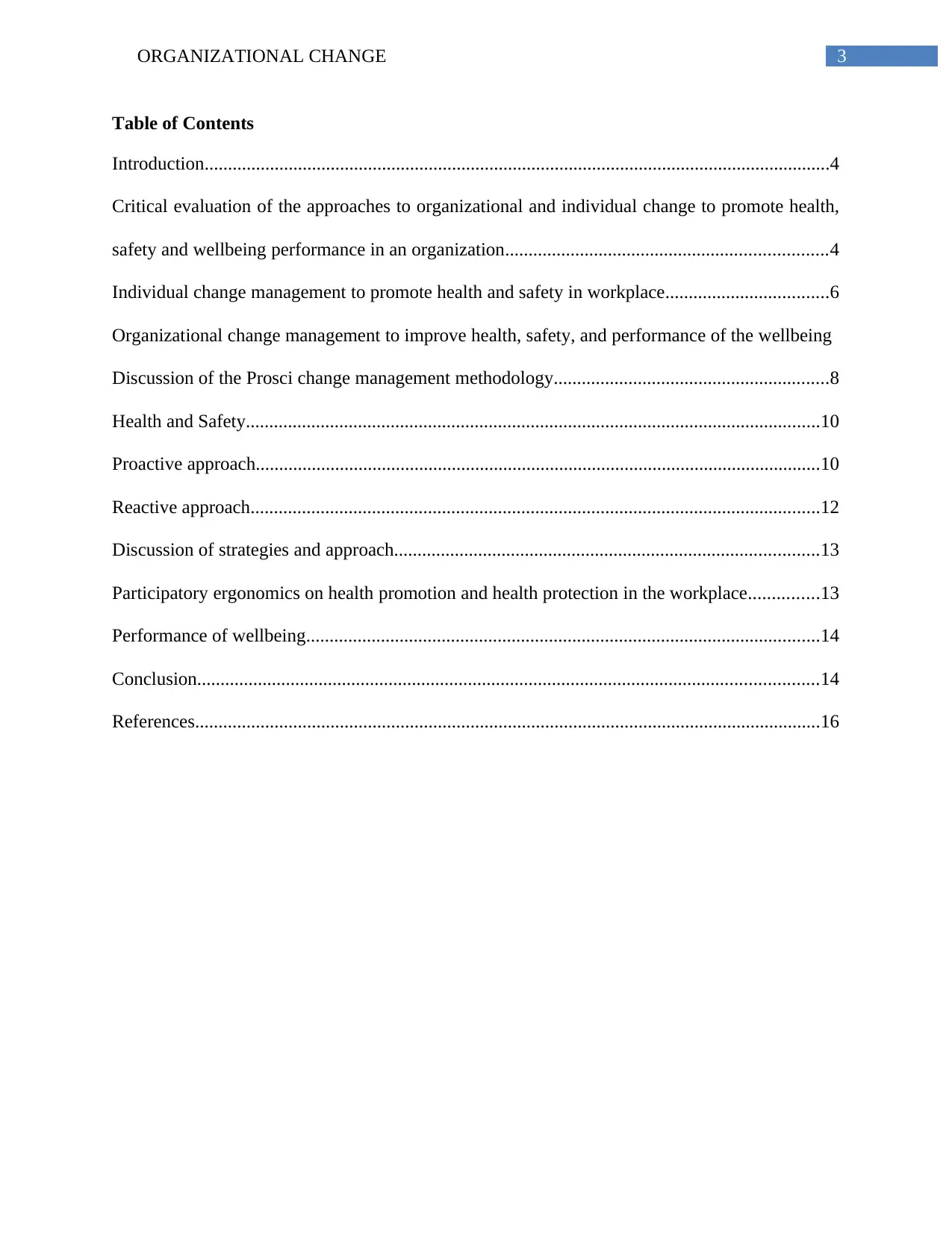
3ORGANIZATIONAL CHANGE
Table of Contents
Introduction......................................................................................................................................4
Critical evaluation of the approaches to organizational and individual change to promote health,
safety and wellbeing performance in an organization.....................................................................4
Individual change management to promote health and safety in workplace...................................6
Organizational change management to improve health, safety, and performance of the wellbeing
Discussion of the Prosci change management methodology...........................................................8
Health and Safety...........................................................................................................................10
Proactive approach.........................................................................................................................10
Reactive approach..........................................................................................................................12
Discussion of strategies and approach...........................................................................................13
Participatory ergonomics on health promotion and health protection in the workplace...............13
Performance of wellbeing..............................................................................................................14
Conclusion.....................................................................................................................................14
References......................................................................................................................................16
Table of Contents
Introduction......................................................................................................................................4
Critical evaluation of the approaches to organizational and individual change to promote health,
safety and wellbeing performance in an organization.....................................................................4
Individual change management to promote health and safety in workplace...................................6
Organizational change management to improve health, safety, and performance of the wellbeing
Discussion of the Prosci change management methodology...........................................................8
Health and Safety...........................................................................................................................10
Proactive approach.........................................................................................................................10
Reactive approach..........................................................................................................................12
Discussion of strategies and approach...........................................................................................13
Participatory ergonomics on health promotion and health protection in the workplace...............13
Performance of wellbeing..............................................................................................................14
Conclusion.....................................................................................................................................14
References......................................................................................................................................16
⊘ This is a preview!⊘
Do you want full access?
Subscribe today to unlock all pages.

Trusted by 1+ million students worldwide
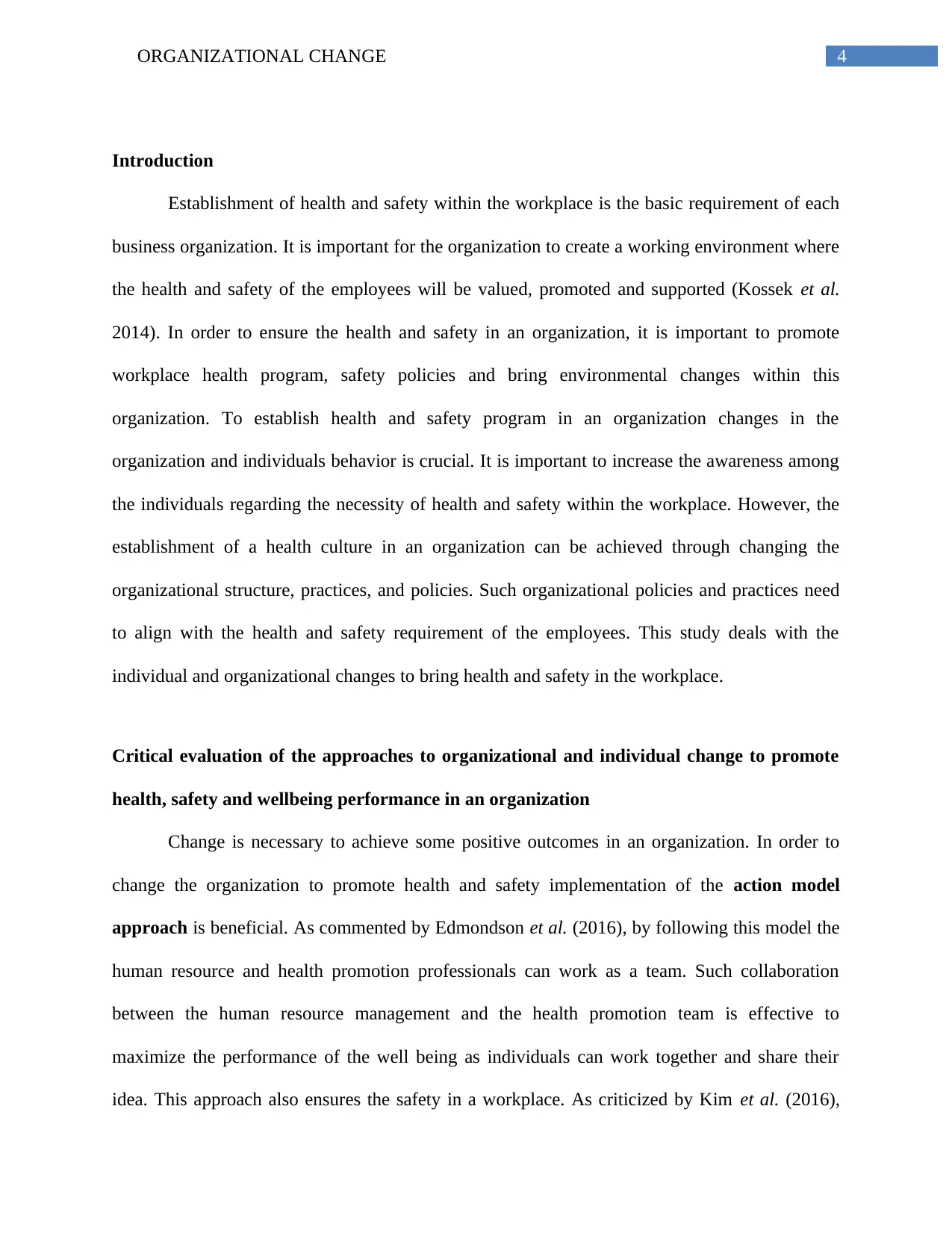
4ORGANIZATIONAL CHANGE
Introduction
Establishment of health and safety within the workplace is the basic requirement of each
business organization. It is important for the organization to create a working environment where
the health and safety of the employees will be valued, promoted and supported (Kossek et al.
2014). In order to ensure the health and safety in an organization, it is important to promote
workplace health program, safety policies and bring environmental changes within this
organization. To establish health and safety program in an organization changes in the
organization and individuals behavior is crucial. It is important to increase the awareness among
the individuals regarding the necessity of health and safety within the workplace. However, the
establishment of a health culture in an organization can be achieved through changing the
organizational structure, practices, and policies. Such organizational policies and practices need
to align with the health and safety requirement of the employees. This study deals with the
individual and organizational changes to bring health and safety in the workplace.
Critical evaluation of the approaches to organizational and individual change to promote
health, safety and wellbeing performance in an organization
Change is necessary to achieve some positive outcomes in an organization. In order to
change the organization to promote health and safety implementation of the action model
approach is beneficial. As commented by Edmondson et al. (2016), by following this model the
human resource and health promotion professionals can work as a team. Such collaboration
between the human resource management and the health promotion team is effective to
maximize the performance of the well being as individuals can work together and share their
idea. This approach also ensures the safety in a workplace. As criticized by Kim et al. (2016),
Introduction
Establishment of health and safety within the workplace is the basic requirement of each
business organization. It is important for the organization to create a working environment where
the health and safety of the employees will be valued, promoted and supported (Kossek et al.
2014). In order to ensure the health and safety in an organization, it is important to promote
workplace health program, safety policies and bring environmental changes within this
organization. To establish health and safety program in an organization changes in the
organization and individuals behavior is crucial. It is important to increase the awareness among
the individuals regarding the necessity of health and safety within the workplace. However, the
establishment of a health culture in an organization can be achieved through changing the
organizational structure, practices, and policies. Such organizational policies and practices need
to align with the health and safety requirement of the employees. This study deals with the
individual and organizational changes to bring health and safety in the workplace.
Critical evaluation of the approaches to organizational and individual change to promote
health, safety and wellbeing performance in an organization
Change is necessary to achieve some positive outcomes in an organization. In order to
change the organization to promote health and safety implementation of the action model
approach is beneficial. As commented by Edmondson et al. (2016), by following this model the
human resource and health promotion professionals can work as a team. Such collaboration
between the human resource management and the health promotion team is effective to
maximize the performance of the well being as individuals can work together and share their
idea. This approach also ensures the safety in a workplace. As criticized by Kim et al. (2016),
Paraphrase This Document
Need a fresh take? Get an instant paraphrase of this document with our AI Paraphraser
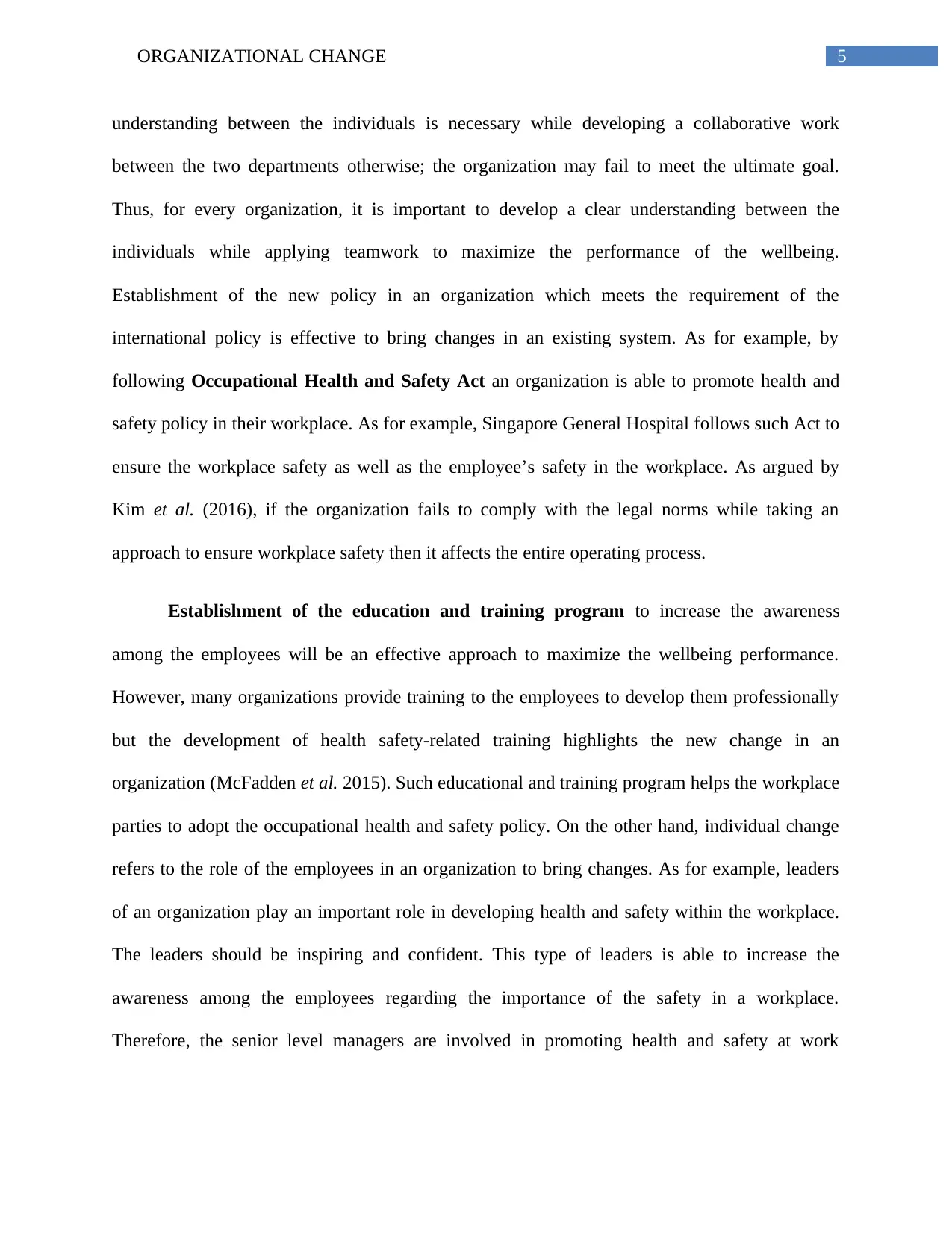
5ORGANIZATIONAL CHANGE
understanding between the individuals is necessary while developing a collaborative work
between the two departments otherwise; the organization may fail to meet the ultimate goal.
Thus, for every organization, it is important to develop a clear understanding between the
individuals while applying teamwork to maximize the performance of the wellbeing.
Establishment of the new policy in an organization which meets the requirement of the
international policy is effective to bring changes in an existing system. As for example, by
following Occupational Health and Safety Act an organization is able to promote health and
safety policy in their workplace. As for example, Singapore General Hospital follows such Act to
ensure the workplace safety as well as the employee’s safety in the workplace. As argued by
Kim et al. (2016), if the organization fails to comply with the legal norms while taking an
approach to ensure workplace safety then it affects the entire operating process.
Establishment of the education and training program to increase the awareness
among the employees will be an effective approach to maximize the wellbeing performance.
However, many organizations provide training to the employees to develop them professionally
but the development of health safety-related training highlights the new change in an
organization (McFadden et al. 2015). Such educational and training program helps the workplace
parties to adopt the occupational health and safety policy. On the other hand, individual change
refers to the role of the employees in an organization to bring changes. As for example, leaders
of an organization play an important role in developing health and safety within the workplace.
The leaders should be inspiring and confident. This type of leaders is able to increase the
awareness among the employees regarding the importance of the safety in a workplace.
Therefore, the senior level managers are involved in promoting health and safety at work
understanding between the individuals is necessary while developing a collaborative work
between the two departments otherwise; the organization may fail to meet the ultimate goal.
Thus, for every organization, it is important to develop a clear understanding between the
individuals while applying teamwork to maximize the performance of the wellbeing.
Establishment of the new policy in an organization which meets the requirement of the
international policy is effective to bring changes in an existing system. As for example, by
following Occupational Health and Safety Act an organization is able to promote health and
safety policy in their workplace. As for example, Singapore General Hospital follows such Act to
ensure the workplace safety as well as the employee’s safety in the workplace. As argued by
Kim et al. (2016), if the organization fails to comply with the legal norms while taking an
approach to ensure workplace safety then it affects the entire operating process.
Establishment of the education and training program to increase the awareness
among the employees will be an effective approach to maximize the wellbeing performance.
However, many organizations provide training to the employees to develop them professionally
but the development of health safety-related training highlights the new change in an
organization (McFadden et al. 2015). Such educational and training program helps the workplace
parties to adopt the occupational health and safety policy. On the other hand, individual change
refers to the role of the employees in an organization to bring changes. As for example, leaders
of an organization play an important role in developing health and safety within the workplace.
The leaders should be inspiring and confident. This type of leaders is able to increase the
awareness among the employees regarding the importance of the safety in a workplace.
Therefore, the senior level managers are involved in promoting health and safety at work
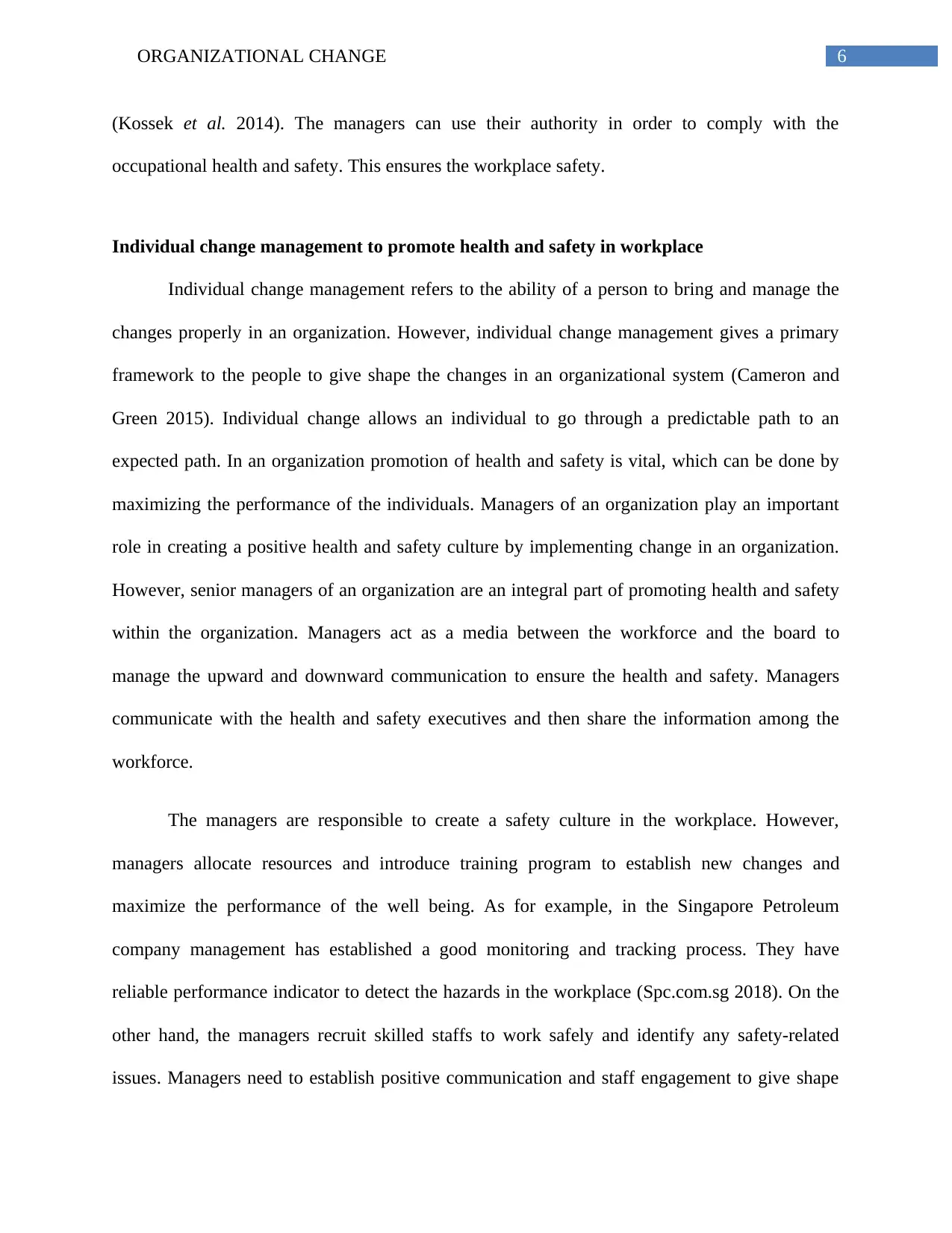
6ORGANIZATIONAL CHANGE
(Kossek et al. 2014). The managers can use their authority in order to comply with the
occupational health and safety. This ensures the workplace safety.
Individual change management to promote health and safety in workplace
Individual change management refers to the ability of a person to bring and manage the
changes properly in an organization. However, individual change management gives a primary
framework to the people to give shape the changes in an organizational system (Cameron and
Green 2015). Individual change allows an individual to go through a predictable path to an
expected path. In an organization promotion of health and safety is vital, which can be done by
maximizing the performance of the individuals. Managers of an organization play an important
role in creating a positive health and safety culture by implementing change in an organization.
However, senior managers of an organization are an integral part of promoting health and safety
within the organization. Managers act as a media between the workforce and the board to
manage the upward and downward communication to ensure the health and safety. Managers
communicate with the health and safety executives and then share the information among the
workforce.
The managers are responsible to create a safety culture in the workplace. However,
managers allocate resources and introduce training program to establish new changes and
maximize the performance of the well being. As for example, in the Singapore Petroleum
company management has established a good monitoring and tracking process. They have
reliable performance indicator to detect the hazards in the workplace (Spc.com.sg 2018). On the
other hand, the managers recruit skilled staffs to work safely and identify any safety-related
issues. Managers need to establish positive communication and staff engagement to give shape
(Kossek et al. 2014). The managers can use their authority in order to comply with the
occupational health and safety. This ensures the workplace safety.
Individual change management to promote health and safety in workplace
Individual change management refers to the ability of a person to bring and manage the
changes properly in an organization. However, individual change management gives a primary
framework to the people to give shape the changes in an organizational system (Cameron and
Green 2015). Individual change allows an individual to go through a predictable path to an
expected path. In an organization promotion of health and safety is vital, which can be done by
maximizing the performance of the individuals. Managers of an organization play an important
role in creating a positive health and safety culture by implementing change in an organization.
However, senior managers of an organization are an integral part of promoting health and safety
within the organization. Managers act as a media between the workforce and the board to
manage the upward and downward communication to ensure the health and safety. Managers
communicate with the health and safety executives and then share the information among the
workforce.
The managers are responsible to create a safety culture in the workplace. However,
managers allocate resources and introduce training program to establish new changes and
maximize the performance of the well being. As for example, in the Singapore Petroleum
company management has established a good monitoring and tracking process. They have
reliable performance indicator to detect the hazards in the workplace (Spc.com.sg 2018). On the
other hand, the managers recruit skilled staffs to work safely and identify any safety-related
issues. Managers need to establish positive communication and staff engagement to give shape
⊘ This is a preview!⊘
Do you want full access?
Subscribe today to unlock all pages.

Trusted by 1+ million students worldwide
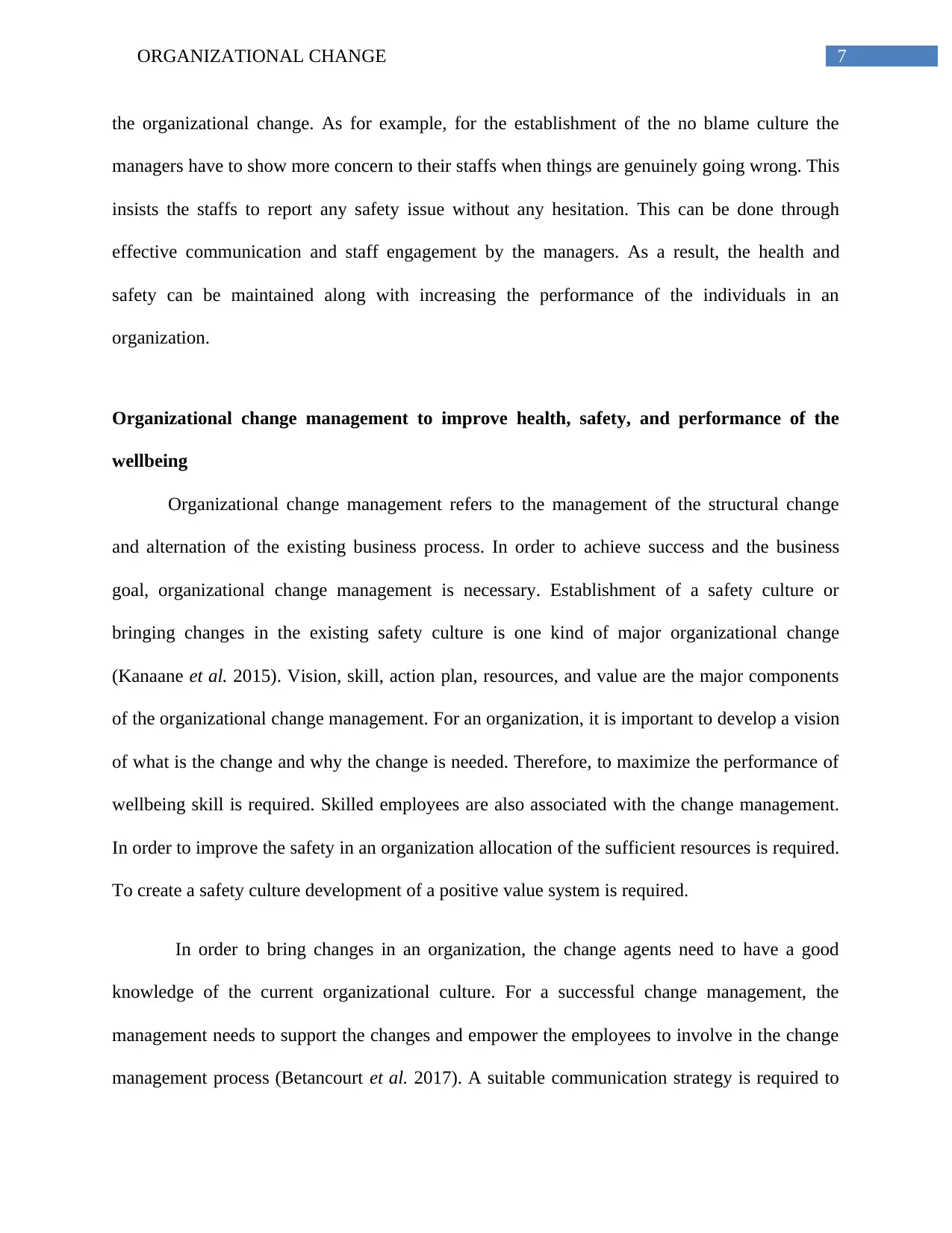
7ORGANIZATIONAL CHANGE
the organizational change. As for example, for the establishment of the no blame culture the
managers have to show more concern to their staffs when things are genuinely going wrong. This
insists the staffs to report any safety issue without any hesitation. This can be done through
effective communication and staff engagement by the managers. As a result, the health and
safety can be maintained along with increasing the performance of the individuals in an
organization.
Organizational change management to improve health, safety, and performance of the
wellbeing
Organizational change management refers to the management of the structural change
and alternation of the existing business process. In order to achieve success and the business
goal, organizational change management is necessary. Establishment of a safety culture or
bringing changes in the existing safety culture is one kind of major organizational change
(Kanaane et al. 2015). Vision, skill, action plan, resources, and value are the major components
of the organizational change management. For an organization, it is important to develop a vision
of what is the change and why the change is needed. Therefore, to maximize the performance of
wellbeing skill is required. Skilled employees are also associated with the change management.
In order to improve the safety in an organization allocation of the sufficient resources is required.
To create a safety culture development of a positive value system is required.
In order to bring changes in an organization, the change agents need to have a good
knowledge of the current organizational culture. For a successful change management, the
management needs to support the changes and empower the employees to involve in the change
management process (Betancourt et al. 2017). A suitable communication strategy is required to
the organizational change. As for example, for the establishment of the no blame culture the
managers have to show more concern to their staffs when things are genuinely going wrong. This
insists the staffs to report any safety issue without any hesitation. This can be done through
effective communication and staff engagement by the managers. As a result, the health and
safety can be maintained along with increasing the performance of the individuals in an
organization.
Organizational change management to improve health, safety, and performance of the
wellbeing
Organizational change management refers to the management of the structural change
and alternation of the existing business process. In order to achieve success and the business
goal, organizational change management is necessary. Establishment of a safety culture or
bringing changes in the existing safety culture is one kind of major organizational change
(Kanaane et al. 2015). Vision, skill, action plan, resources, and value are the major components
of the organizational change management. For an organization, it is important to develop a vision
of what is the change and why the change is needed. Therefore, to maximize the performance of
wellbeing skill is required. Skilled employees are also associated with the change management.
In order to improve the safety in an organization allocation of the sufficient resources is required.
To create a safety culture development of a positive value system is required.
In order to bring changes in an organization, the change agents need to have a good
knowledge of the current organizational culture. For a successful change management, the
management needs to support the changes and empower the employees to involve in the change
management process (Betancourt et al. 2017). A suitable communication strategy is required to
Paraphrase This Document
Need a fresh take? Get an instant paraphrase of this document with our AI Paraphraser
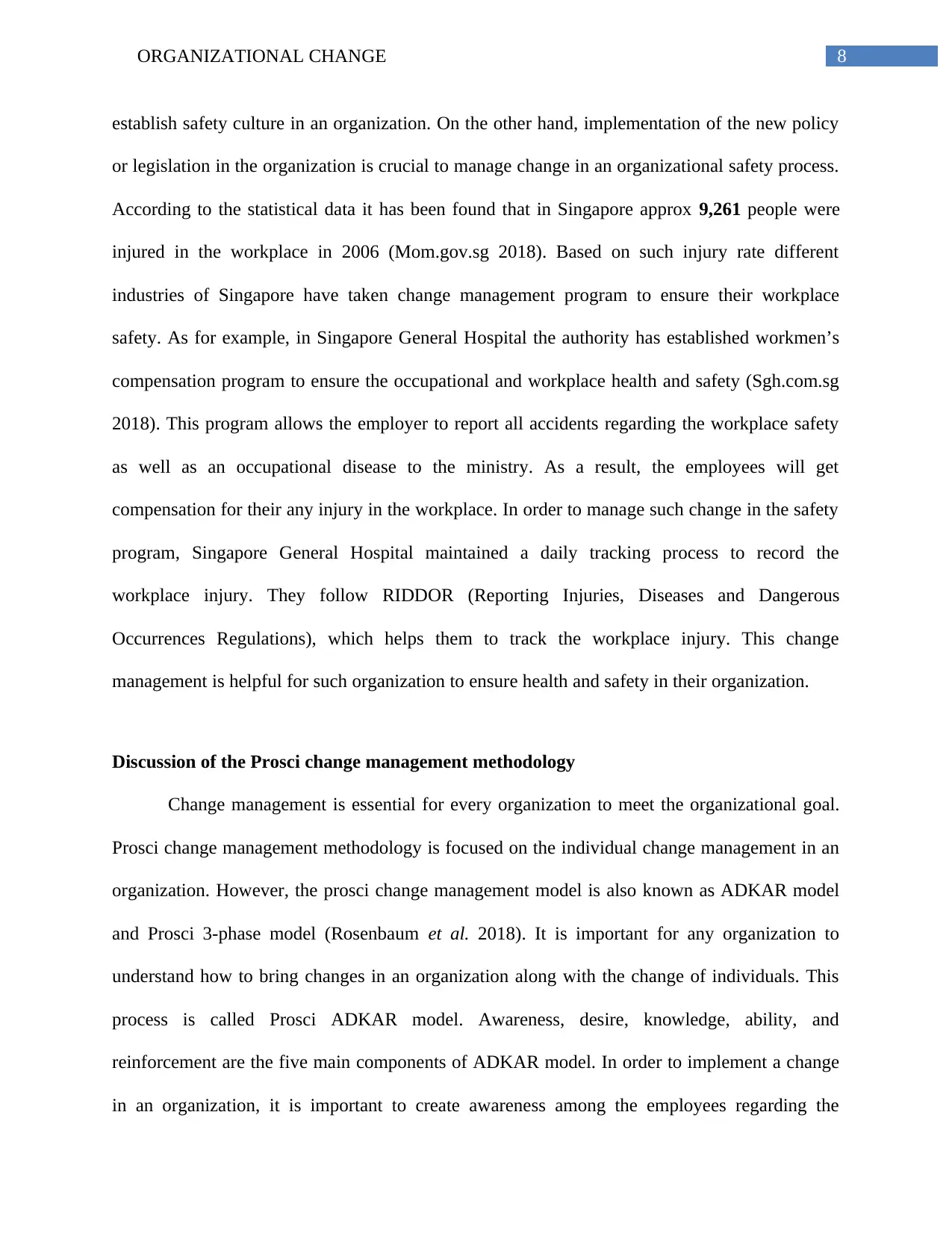
8ORGANIZATIONAL CHANGE
establish safety culture in an organization. On the other hand, implementation of the new policy
or legislation in the organization is crucial to manage change in an organizational safety process.
According to the statistical data it has been found that in Singapore approx 9,261 people were
injured in the workplace in 2006 (Mom.gov.sg 2018). Based on such injury rate different
industries of Singapore have taken change management program to ensure their workplace
safety. As for example, in Singapore General Hospital the authority has established workmen’s
compensation program to ensure the occupational and workplace health and safety (Sgh.com.sg
2018). This program allows the employer to report all accidents regarding the workplace safety
as well as an occupational disease to the ministry. As a result, the employees will get
compensation for their any injury in the workplace. In order to manage such change in the safety
program, Singapore General Hospital maintained a daily tracking process to record the
workplace injury. They follow RIDDOR (Reporting Injuries, Diseases and Dangerous
Occurrences Regulations), which helps them to track the workplace injury. This change
management is helpful for such organization to ensure health and safety in their organization.
Discussion of the Prosci change management methodology
Change management is essential for every organization to meet the organizational goal.
Prosci change management methodology is focused on the individual change management in an
organization. However, the prosci change management model is also known as ADKAR model
and Prosci 3-phase model (Rosenbaum et al. 2018). It is important for any organization to
understand how to bring changes in an organization along with the change of individuals. This
process is called Prosci ADKAR model. Awareness, desire, knowledge, ability, and
reinforcement are the five main components of ADKAR model. In order to implement a change
in an organization, it is important to create awareness among the employees regarding the
establish safety culture in an organization. On the other hand, implementation of the new policy
or legislation in the organization is crucial to manage change in an organizational safety process.
According to the statistical data it has been found that in Singapore approx 9,261 people were
injured in the workplace in 2006 (Mom.gov.sg 2018). Based on such injury rate different
industries of Singapore have taken change management program to ensure their workplace
safety. As for example, in Singapore General Hospital the authority has established workmen’s
compensation program to ensure the occupational and workplace health and safety (Sgh.com.sg
2018). This program allows the employer to report all accidents regarding the workplace safety
as well as an occupational disease to the ministry. As a result, the employees will get
compensation for their any injury in the workplace. In order to manage such change in the safety
program, Singapore General Hospital maintained a daily tracking process to record the
workplace injury. They follow RIDDOR (Reporting Injuries, Diseases and Dangerous
Occurrences Regulations), which helps them to track the workplace injury. This change
management is helpful for such organization to ensure health and safety in their organization.
Discussion of the Prosci change management methodology
Change management is essential for every organization to meet the organizational goal.
Prosci change management methodology is focused on the individual change management in an
organization. However, the prosci change management model is also known as ADKAR model
and Prosci 3-phase model (Rosenbaum et al. 2018). It is important for any organization to
understand how to bring changes in an organization along with the change of individuals. This
process is called Prosci ADKAR model. Awareness, desire, knowledge, ability, and
reinforcement are the five main components of ADKAR model. In order to implement a change
in an organization, it is important to create awareness among the employees regarding the
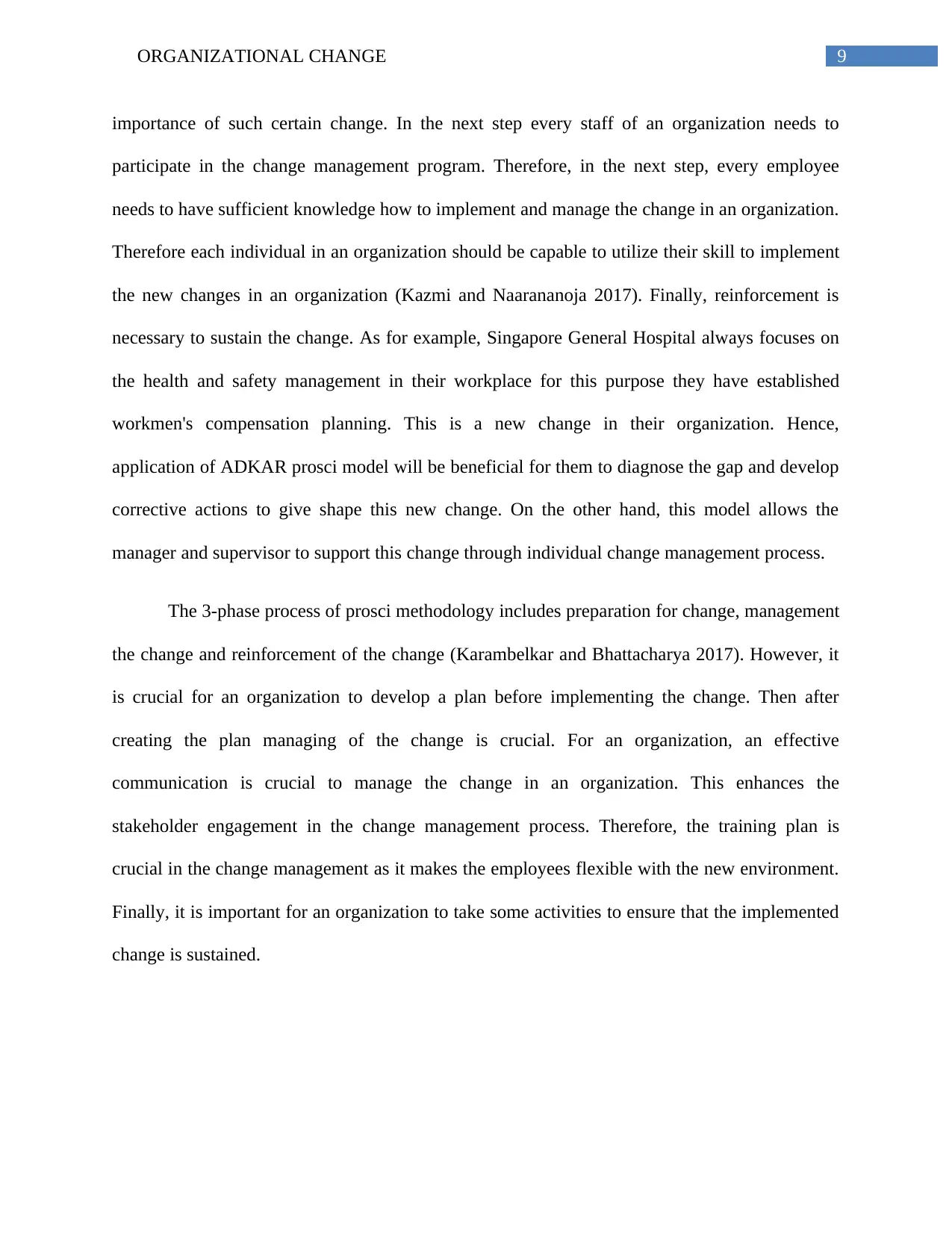
9ORGANIZATIONAL CHANGE
importance of such certain change. In the next step every staff of an organization needs to
participate in the change management program. Therefore, in the next step, every employee
needs to have sufficient knowledge how to implement and manage the change in an organization.
Therefore each individual in an organization should be capable to utilize their skill to implement
the new changes in an organization (Kazmi and Naarananoja 2017). Finally, reinforcement is
necessary to sustain the change. As for example, Singapore General Hospital always focuses on
the health and safety management in their workplace for this purpose they have established
workmen's compensation planning. This is a new change in their organization. Hence,
application of ADKAR prosci model will be beneficial for them to diagnose the gap and develop
corrective actions to give shape this new change. On the other hand, this model allows the
manager and supervisor to support this change through individual change management process.
The 3-phase process of prosci methodology includes preparation for change, management
the change and reinforcement of the change (Karambelkar and Bhattacharya 2017). However, it
is crucial for an organization to develop a plan before implementing the change. Then after
creating the plan managing of the change is crucial. For an organization, an effective
communication is crucial to manage the change in an organization. This enhances the
stakeholder engagement in the change management process. Therefore, the training plan is
crucial in the change management as it makes the employees flexible with the new environment.
Finally, it is important for an organization to take some activities to ensure that the implemented
change is sustained.
importance of such certain change. In the next step every staff of an organization needs to
participate in the change management program. Therefore, in the next step, every employee
needs to have sufficient knowledge how to implement and manage the change in an organization.
Therefore each individual in an organization should be capable to utilize their skill to implement
the new changes in an organization (Kazmi and Naarananoja 2017). Finally, reinforcement is
necessary to sustain the change. As for example, Singapore General Hospital always focuses on
the health and safety management in their workplace for this purpose they have established
workmen's compensation planning. This is a new change in their organization. Hence,
application of ADKAR prosci model will be beneficial for them to diagnose the gap and develop
corrective actions to give shape this new change. On the other hand, this model allows the
manager and supervisor to support this change through individual change management process.
The 3-phase process of prosci methodology includes preparation for change, management
the change and reinforcement of the change (Karambelkar and Bhattacharya 2017). However, it
is crucial for an organization to develop a plan before implementing the change. Then after
creating the plan managing of the change is crucial. For an organization, an effective
communication is crucial to manage the change in an organization. This enhances the
stakeholder engagement in the change management process. Therefore, the training plan is
crucial in the change management as it makes the employees flexible with the new environment.
Finally, it is important for an organization to take some activities to ensure that the implemented
change is sustained.
⊘ This is a preview!⊘
Do you want full access?
Subscribe today to unlock all pages.

Trusted by 1+ million students worldwide
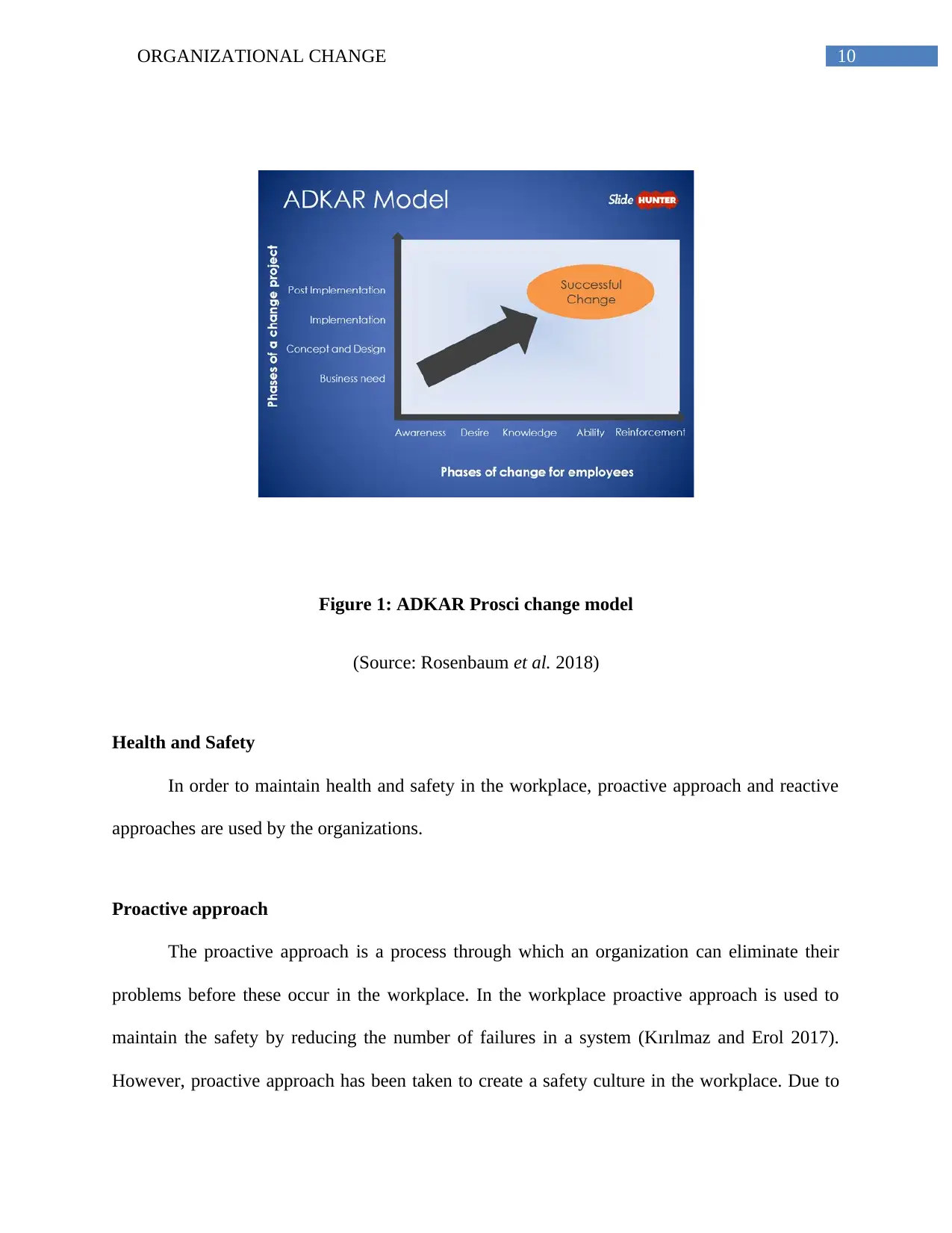
10ORGANIZATIONAL CHANGE
Figure 1: ADKAR Prosci change model
(Source: Rosenbaum et al. 2018)
Health and Safety
In order to maintain health and safety in the workplace, proactive approach and reactive
approaches are used by the organizations.
Proactive approach
The proactive approach is a process through which an organization can eliminate their
problems before these occur in the workplace. In the workplace proactive approach is used to
maintain the safety by reducing the number of failures in a system (Kırılmaz and Erol 2017).
However, proactive approach has been taken to create a safety culture in the workplace. Due to
Figure 1: ADKAR Prosci change model
(Source: Rosenbaum et al. 2018)
Health and Safety
In order to maintain health and safety in the workplace, proactive approach and reactive
approaches are used by the organizations.
Proactive approach
The proactive approach is a process through which an organization can eliminate their
problems before these occur in the workplace. In the workplace proactive approach is used to
maintain the safety by reducing the number of failures in a system (Kırılmaz and Erol 2017).
However, proactive approach has been taken to create a safety culture in the workplace. Due to
Paraphrase This Document
Need a fresh take? Get an instant paraphrase of this document with our AI Paraphraser
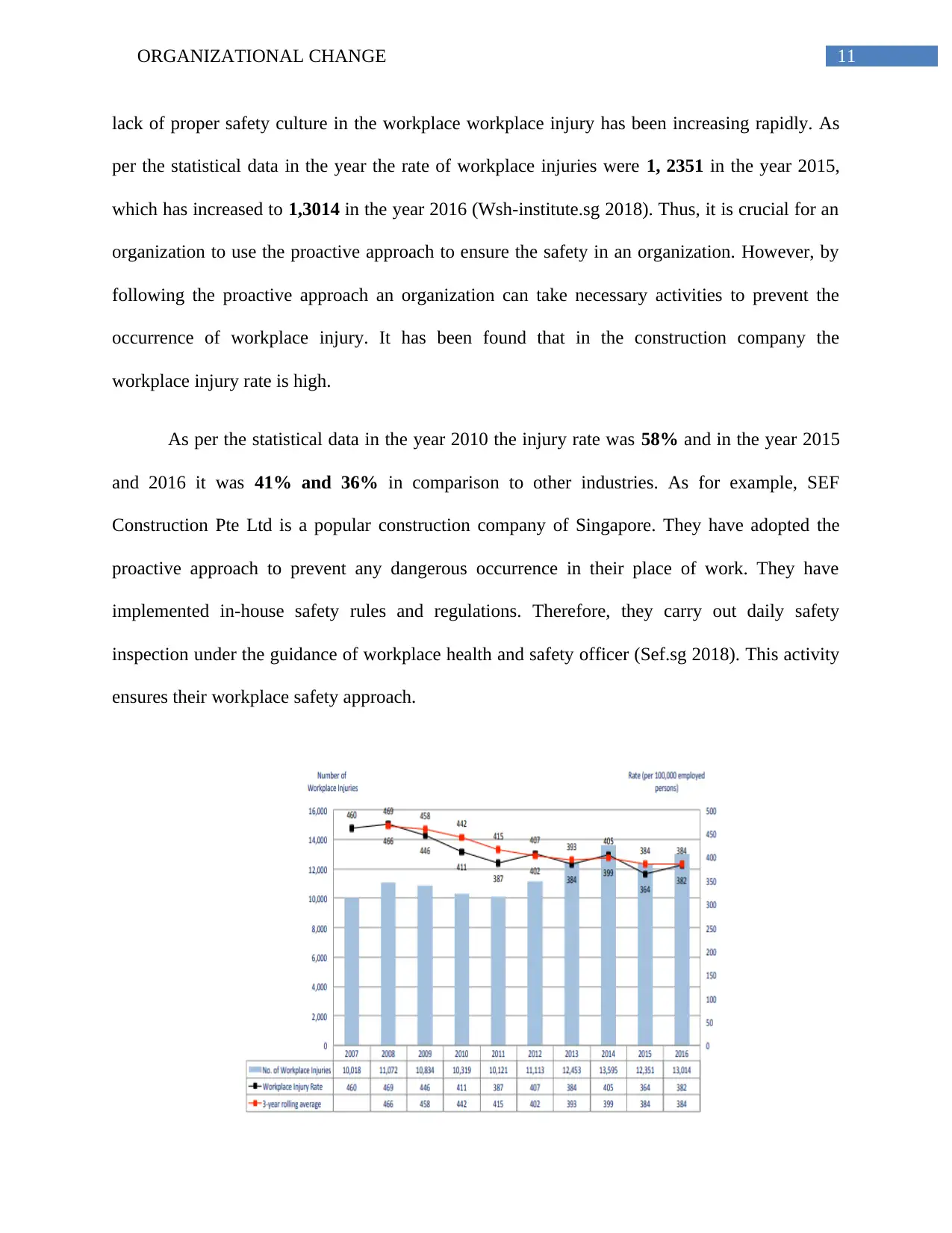
11ORGANIZATIONAL CHANGE
lack of proper safety culture in the workplace workplace injury has been increasing rapidly. As
per the statistical data in the year the rate of workplace injuries were 1, 2351 in the year 2015,
which has increased to 1,3014 in the year 2016 (Wsh-institute.sg 2018). Thus, it is crucial for an
organization to use the proactive approach to ensure the safety in an organization. However, by
following the proactive approach an organization can take necessary activities to prevent the
occurrence of workplace injury. It has been found that in the construction company the
workplace injury rate is high.
As per the statistical data in the year 2010 the injury rate was 58% and in the year 2015
and 2016 it was 41% and 36% in comparison to other industries. As for example, SEF
Construction Pte Ltd is a popular construction company of Singapore. They have adopted the
proactive approach to prevent any dangerous occurrence in their place of work. They have
implemented in-house safety rules and regulations. Therefore, they carry out daily safety
inspection under the guidance of workplace health and safety officer (Sef.sg 2018). This activity
ensures their workplace safety approach.
lack of proper safety culture in the workplace workplace injury has been increasing rapidly. As
per the statistical data in the year the rate of workplace injuries were 1, 2351 in the year 2015,
which has increased to 1,3014 in the year 2016 (Wsh-institute.sg 2018). Thus, it is crucial for an
organization to use the proactive approach to ensure the safety in an organization. However, by
following the proactive approach an organization can take necessary activities to prevent the
occurrence of workplace injury. It has been found that in the construction company the
workplace injury rate is high.
As per the statistical data in the year 2010 the injury rate was 58% and in the year 2015
and 2016 it was 41% and 36% in comparison to other industries. As for example, SEF
Construction Pte Ltd is a popular construction company of Singapore. They have adopted the
proactive approach to prevent any dangerous occurrence in their place of work. They have
implemented in-house safety rules and regulations. Therefore, they carry out daily safety
inspection under the guidance of workplace health and safety officer (Sef.sg 2018). This activity
ensures their workplace safety approach.
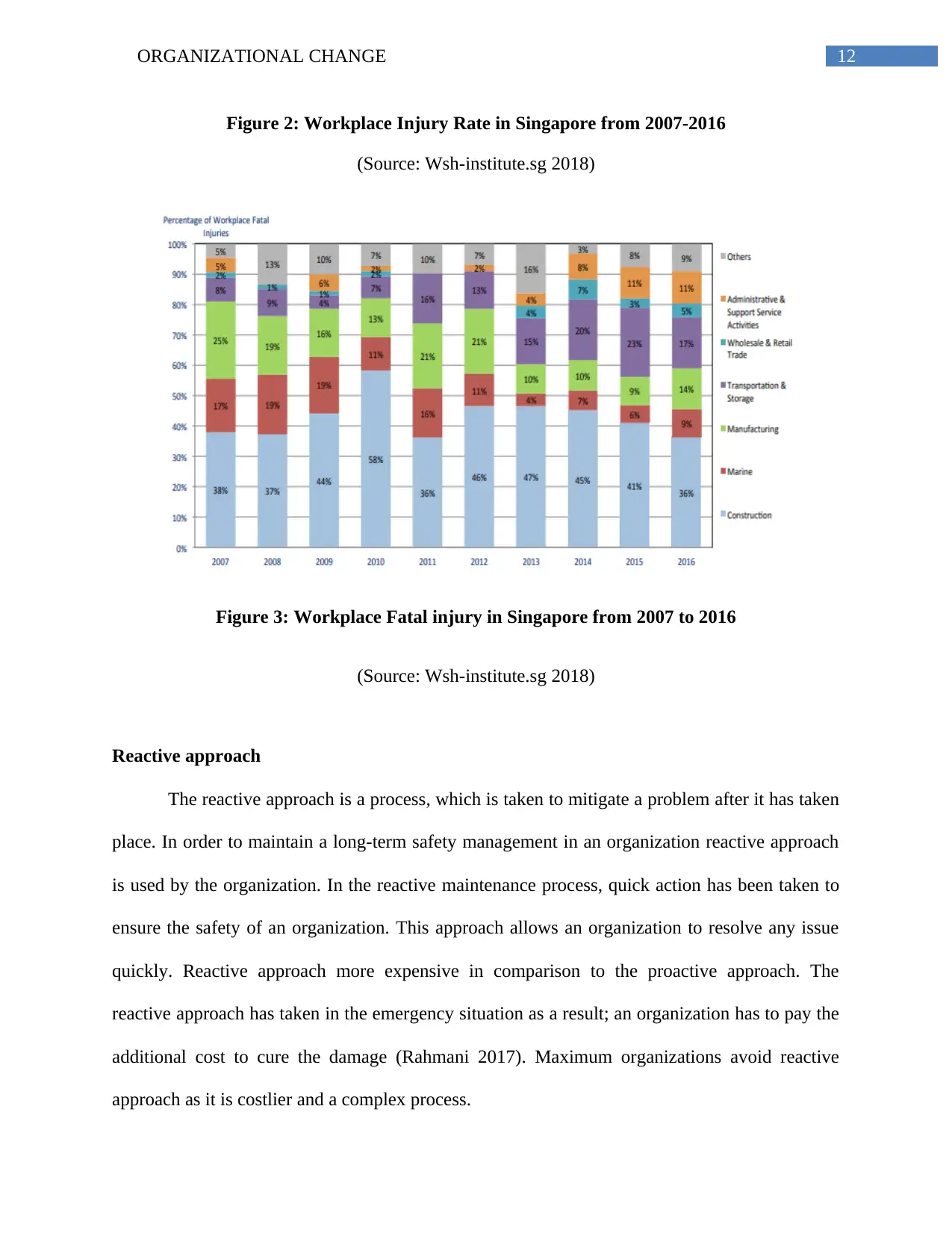
12ORGANIZATIONAL CHANGE
Figure 2: Workplace Injury Rate in Singapore from 2007-2016
(Source: Wsh-institute.sg 2018)
Figure 3: Workplace Fatal injury in Singapore from 2007 to 2016
(Source: Wsh-institute.sg 2018)
Reactive approach
The reactive approach is a process, which is taken to mitigate a problem after it has taken
place. In order to maintain a long-term safety management in an organization reactive approach
is used by the organization. In the reactive maintenance process, quick action has been taken to
ensure the safety of an organization. This approach allows an organization to resolve any issue
quickly. Reactive approach more expensive in comparison to the proactive approach. The
reactive approach has taken in the emergency situation as a result; an organization has to pay the
additional cost to cure the damage (Rahmani 2017). Maximum organizations avoid reactive
approach as it is costlier and a complex process.
Figure 2: Workplace Injury Rate in Singapore from 2007-2016
(Source: Wsh-institute.sg 2018)
Figure 3: Workplace Fatal injury in Singapore from 2007 to 2016
(Source: Wsh-institute.sg 2018)
Reactive approach
The reactive approach is a process, which is taken to mitigate a problem after it has taken
place. In order to maintain a long-term safety management in an organization reactive approach
is used by the organization. In the reactive maintenance process, quick action has been taken to
ensure the safety of an organization. This approach allows an organization to resolve any issue
quickly. Reactive approach more expensive in comparison to the proactive approach. The
reactive approach has taken in the emergency situation as a result; an organization has to pay the
additional cost to cure the damage (Rahmani 2017). Maximum organizations avoid reactive
approach as it is costlier and a complex process.
⊘ This is a preview!⊘
Do you want full access?
Subscribe today to unlock all pages.

Trusted by 1+ million students worldwide
1 out of 18
Related Documents
Your All-in-One AI-Powered Toolkit for Academic Success.
+13062052269
info@desklib.com
Available 24*7 on WhatsApp / Email
![[object Object]](/_next/static/media/star-bottom.7253800d.svg)
Unlock your academic potential
Copyright © 2020–2025 A2Z Services. All Rights Reserved. Developed and managed by ZUCOL.




